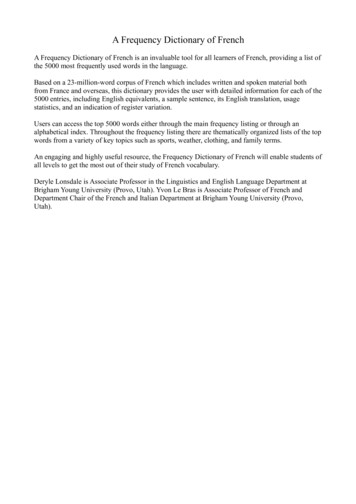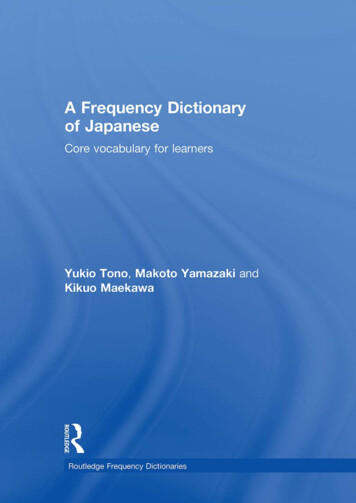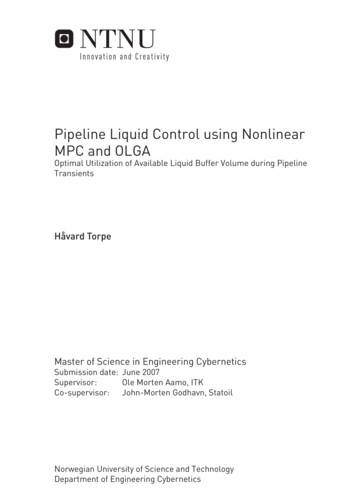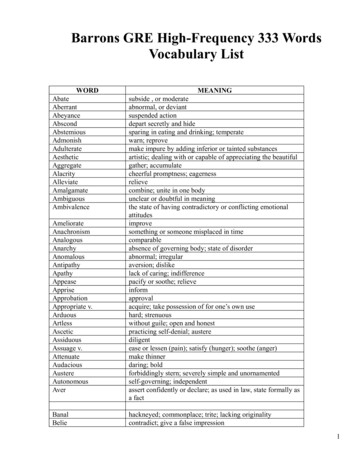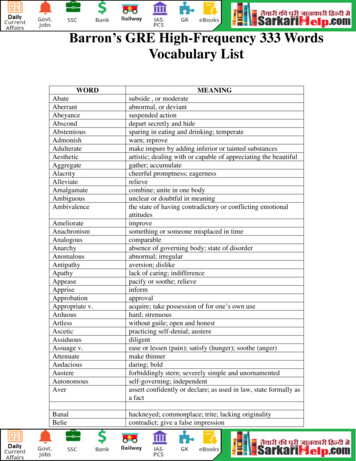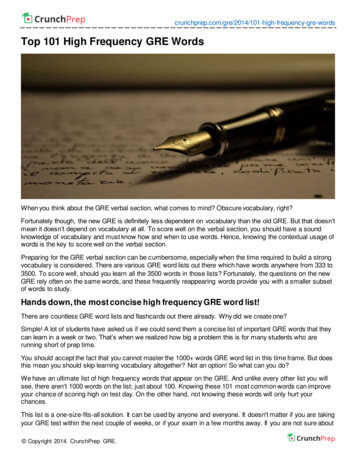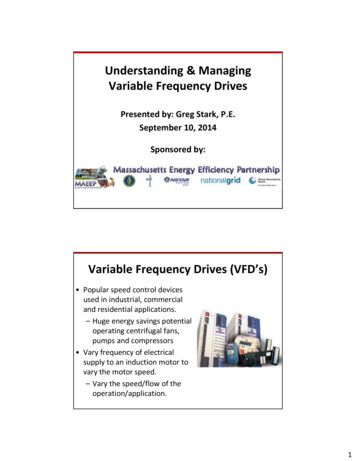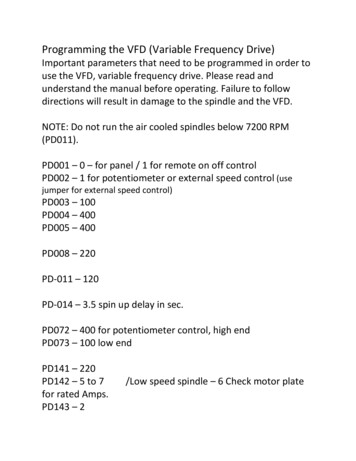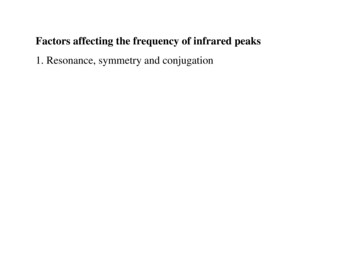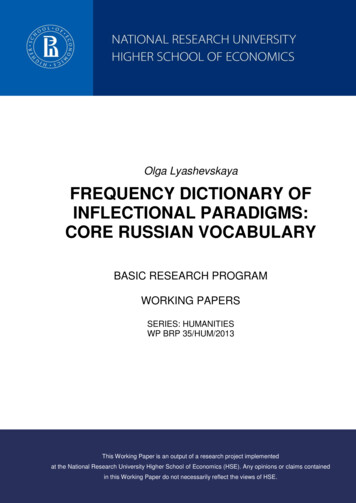
Transcription
Olga LyashevskayaFREQUENCY DICTIONARY OFINFLECTIONAL PARADIGMS:CORE RUSSIAN VOCABULARYBASIC RESEARCH PROGRAMWORKING PAPERSSERIES: HUMANITIESWP BRP 35/HUM/2013This Working Paper is an output of a research project implementedat the National Research University Higher School of Economics (HSE). Any opinions or claims containedin this Working Paper do not necessarily reflect the views of HSE.
Olga Lyashevskaya1FREQUENCY DICTIONARY OF INFLECTIONAL PARADIGMS:CORE RUSSIAN VOCABULARY2A new kind of frequency dictionary is a valuable reference for researchers and students ofRussian. It shows the grammatical profiles of nouns, adjectives, and verbs, namely thedistribution of grammatical forms in the inflectional paradigm. The dictionary is based on datafrom the Russian National Corpus (RNC) and covers a core vocabulary (5,000 most frequentlyused lexemes).Russian is a morphologically rich language: its noun paradigms harbor two dozen case andnumber forms, while verb paradigms include up to 160 grammatical forms. The dictionarydeparts from traditional frequency lexicography in several ways: 1) word forms are arranged inparadigms, so their frequencies can be compared and ranked; 2) the dictionary is focused on thegrammatical profiles of individual lexemes, rather than on the overall distribution of grammaticalfeatures (e.g., the fact that Future forms are used less frequently than Past forms); 3) thegrammatical profiles of lexical units can be compared against the mean scores of their lexicosemantic class; 4) in each part of speech or semantic class, lexemes with certain biases in thegrammatical profile can be easily detected (e.g. verbs used mostly in the Imperative, Past neutral,or nouns often used in the plural); and, 5) the distribution of homonymous word forms andgrammatical variants can be followed over time and within certain genres and registers. Thedictionary will be a source for research in the field of Russian grammar, paradigm structure,form acquisition, grammatical semantics, as well as variation of grammatical forms.The main challenge for this initiative is the intra-paradigm and inter-paradigm homonymy ofword forms in the corpus data. Manual disambiguation is accurate but covers approximately fivemillion words in the RNC, so the data may be sparse and possibly unreliable. Automaticdisambiguation yields slightly worse results. However, a larger corpus shows more reliable datafor rare word forms. A user can switch between a ‛basicʼ version, which is based on a smallercollection of manually disambiguated texts, and an ‛expandedʼ version, which is based on themain corpus, a newspaper corpus, a corpus of poetry, and the spoken corpus (320 million wordsin total).The article addresses some general issues, such as establishing the common basis of comparison,a level of granularity for the grammatical profile, and units of measurement. We suggest certainsolutions related to the selection of data, corpus data processing, and maintaining the onlineversion of the frequency dictionary.JEL Classification: Z.Key words: frequency dictionary, grammatical profile, inflection, grammatical homonymy,grammatical variation, Russian, Russian National Corpus.1National Research University Higher School of Economics, Moscow / University of Helsinki;Phone: 7 906 798 60 21; email: olesar@gmail.com; www: http://olesar.narod.ru.2This study comprises research findings from ‛A frequency dictionary of Russian grammar and lexical co-occurrenceʼ, a projectcarried out within The National Research University Higher School of Economics Academic Fund Program in 2012-2013, grantNo. 11-01-0171.
1. Toward lexicon-oriented grammarSome time ago, object-oriented programming revolutionized the world of computertechnologies, the software industry, and the interfaces of web resources. A long list of step-bystep instructions that automated everything was replaced with sets of objects with sharedattributes and behavior. It is now objects that monitor the environment for events and triggerassigned functions. The metaphor of rules and objects can be easily applied to the grammar ofnatural language. What if grammar is a self-organizing community of words rather than a generalwho leads the battle? What if the local grammar that these words evoke are more efficient andpowerful? Could we prove that the local effects are still systematic and not random? This articlereports on an experimental frequency dictionary that aims to provide evidence to answer thesequestions.A pilot frequency dictionary shows the inflectional paradigm structure of the 5,000 mostfrequent Russian nouns, adjectives, and verbs. It follows a series of frequency dictionaries basedon data from the Russian National Corpus.3 Our lexico-grammatical dictionary presents acomprehensive account of how inflection works, thus filling the gap between data on lexicalfrequency and grammatical frequency.As a general practice, most frequency dictionaries present a distribution of lexical data either atthe level of tokens or at the lemma level (Leech et al. 2001, Davies and Gardner 2010 forEnglish, Davies 2005 for Spanish, Čermák et al. 2010 for Czech, Sharoff et al. in press forRussian, etc.). In addition, the number of words in different parts of speech classes can be given.However, rarely does any frequency dictionary in the morphologically rich languages includeinformation about the structure of the paradigm and grammatical form frequencies. The onlyexception we are aware of is Šteinfeldt (1963,1970), which calculates the frequency of 961Russian nouns in each case and number form, as well as the distribution of some verbs in tenseand mood.As for grammatical frequency data, despite the fact that the task of constructing frequency inRussian grammar has long been recognized and promoted in the literature (Mustajoki 1973, Ilolaand Mustajoki 1989, Baerman et al. 2010), the quantitative research is mostly focused on nonlexical units: part of speech classes, grammatical classes (hierarchies of case marking, agreementmarkers, etc.), as well as morphemes (Šajkevich et al. 2008).Our project shifts the focus from the distribution of grammatical classes and categories toparticular word forms as structured by the inflectional paradigm. Of particular concern are wordswith certain biases in the grammatical profile, such as: verbs used mostly in the imperative; verbs never used in the past neutral; nouns often used in the plural; nouns with low rates of usage in the nominative form.The dictionary will be a source for much future research in the area of Russian grammar,paradigm structure, grammatical semantics, as well as the variation and alternation ofgrammatical forms (Graudina et al. 1976). It will provide a detailed account of the gradual natureof some important phenomena such as singularia and pluralia tantum. Data from the RNCprovide a great opportunity to answer many research questions, taking into account currenttechnologies of corpus linguistics.3See Lyashevskaya and Sharoff (2009), who generate a general frequency dictionary of 50,000 words, and the onlinegrammatical and collocational dictionaries found at http://dict.ruslang.ru2
This article presents a short introduction to the structure of Russian paradigms in Section 2,examines the background of the lexico-centric approach to frequency grammar in Section 3,discusses various types of information available in the dictionary in Section 4, and mentionssome issues associated with the processing and interpretation of the frequency data in Section 5and in the Conclusion.2. The structure of Russian paradigmsThe data set in the dictionary is based on the morphological standard of the RNC (Lyashevskayaet al. 2005), which generally follows the paradigm inventory developed in the grammaticaldictionary (Zaliznjak 1974). The dictionary takes into account only single-word forms, notparaphrastic forms, such as conditional forms with the particle by, imperfective future andpassive participle constructions with the auxiliary byt’ (‘to be’), analytical forms of thecomparative degree, etc.The paradigm of Russian nouns has up to 17 cells: two grammatical numbers multiplied by sixmajor cases (nominative, genitive, dative, accusative, instrumental, and locative), plus five minorforms that some words take in the singular: the so-called ‘second’ genitive, ‘second’ accusative,‘second locative’, vocative, and adnumerative.The adjectival paradigm has at least 32 cells: 26 inflected long forms (three genders in thesingular and the plural multiplied by six cases; in addition, the masculine and the pluraladjectives distinguish between two types – animate and inanimate – of the accusative forms),four short forms (three genders in the singular and the plural), and two comparative forms.Zaliznjak’s grammatical dictionary (Zaliznjak 1974) and the morphological standard of the RNCexclude from the standard paradigm some archaic short forms with case endings and thesuperlative forms that have the same declension as the full forms. Russian pronouns andnumerals function either as nouns or as adjectives.There is a considerable syncretism within the nominal paradigm. Some case forms are fairlyhomonymous. For example, the accusative and the nominative forms of inanimate nouns, theaccusative and the genitive forms of animate nouns (except for the feminine singular that has sixdistinct case forms), the genitive, dative, instrumental, and locative forms of many adjectives inthe singular, etc.The paradigm of verbal forms has less cohesion among its forms than the declension of nouns.Imperfective and perfective verbs are considered to be separate lexical units and have a slightlydifferent paradigm structure. The non-past forms express the present tense for imperfective verbsand future tense for perfective verbs and distinguish three grammatical persons and twonumbers. The past tense has four forms – three genders in the singular and the plural. Imperativeforms distinguish between the first and second person, and singular and plural, plus a minorinclusive form. The non-past and past forms are usually used in the active-middle voice; passiveforms formed with the reflexive –sja affix are almost non-existent but potentially double thenumber of indicative forms. The imperfective has two gerunds for present and past tense,whereas perfective verbs form only the past gerund. Imperfective verbs can have up to fourparticiples (the present active, past active, present passive and past passive participles), whereasperfective verbs have two (the past active and past passive participles). Each participle can havea full complement of twenty-four adjectival full forms and four short forms. The infinitive hasonly one form and is a basic dictionary form of the verb.3. Why mean frequencies may not always helpWhen linguists talk about frequency grammar, they presumably refer to a specific type ofquantitative data like the frequency ratio for part of speech classes, and the frequency hierarchyof cases and other grammatical categories. The topic of case-frequency distribution is3
particularly popular in Russian linguistics: Kopotev (2008) cites three studies that werepublished during 1959-1961, and there are many more recent publications that report researchresults based on various digitized text samples.Kopotev (2008) draws attention to the stability of frequency data in large and small corpora (seeTable 1). The first two sets of data are based on the modern corpora (RNC and HANKO), whilethe two others are drawn from the earlier frequency dictionaries based on datasets smaller than0.5 MW. Kopotev concludes that the modern corpora agree quite well in the assessment of themean probability of case occurrences, and the differences lie in the structure of text collection interms of 10%19.50%7.80%9.40%Table 1. Frequency distribution of six Russian cases in Kopotev (2008: 142).However, the principle of ‘choose genitive if unsure’ may easily mislead a student of Russian asa foreign language if he or she has to choose an appropriate case for the word shepot (whisper).Table 2 shows that the frequency distribution of cases within some nominal paradigms deviatessignificantly from a typical pattern.NomGenDatAccInsLocTotal 98Table 2. The grammatical profile of the nouns shepot (whisper), poza (posture),, and tropinka(walking path). (Case forms in singular.)In as early as 1974 Greenberg proposed a hypothesis that different semantic groups may have adifferent distribution of cases – both with prepositions and without them (Greenberg 1974,1991).The choice of Russian as an object of study is not accidental: his hypothesis testing is carried outon data from the aforementioned frequency dictionary (Šteinfeldt 1963, source corpus 0.4 MW).Greenberg classifies one half of the nouns into twelve categories (animals, body parts, timeperiods, etc.), and calculates the average frequency of each group for each case. As expected, theplace names are used mostly in the accusative and locative form, while the dative shows a highervalue in personal pronouns (1st and 2nd person) (see Table 3). However, not every episode isexplained that easily.4
1. All nouns2. Commonnouns3. Propernouns4. Personalcommonindividual5. Personalcollective6. Animal7. Body parts8. Concretecount9. Concretemass10. Nonenduringobjects11. Abstractqualities12. Placenouns13. Placeinstitutions14. Timeperiods15. Measures16. First andsecondpersonpronounsNo. oftypes9.073*No. 99312.5657463.31823.935.618.248.028.49.9
FREQUENCY DICTIONARY OF INFLECTIONAL PARADIGMS: CORE RUSSIAN VOCABULARY2 A new kind of frequency dictionary is a valuable reference for researchers and students of Russian. It shows the grammatical profiles of nouns, adjectives, and verbs, namely the distribution of grammatical forms in the inflectional paradigm. The dictionary is based on dataAuthor: Lyashevskaya OlgaPublish Year: 2013
